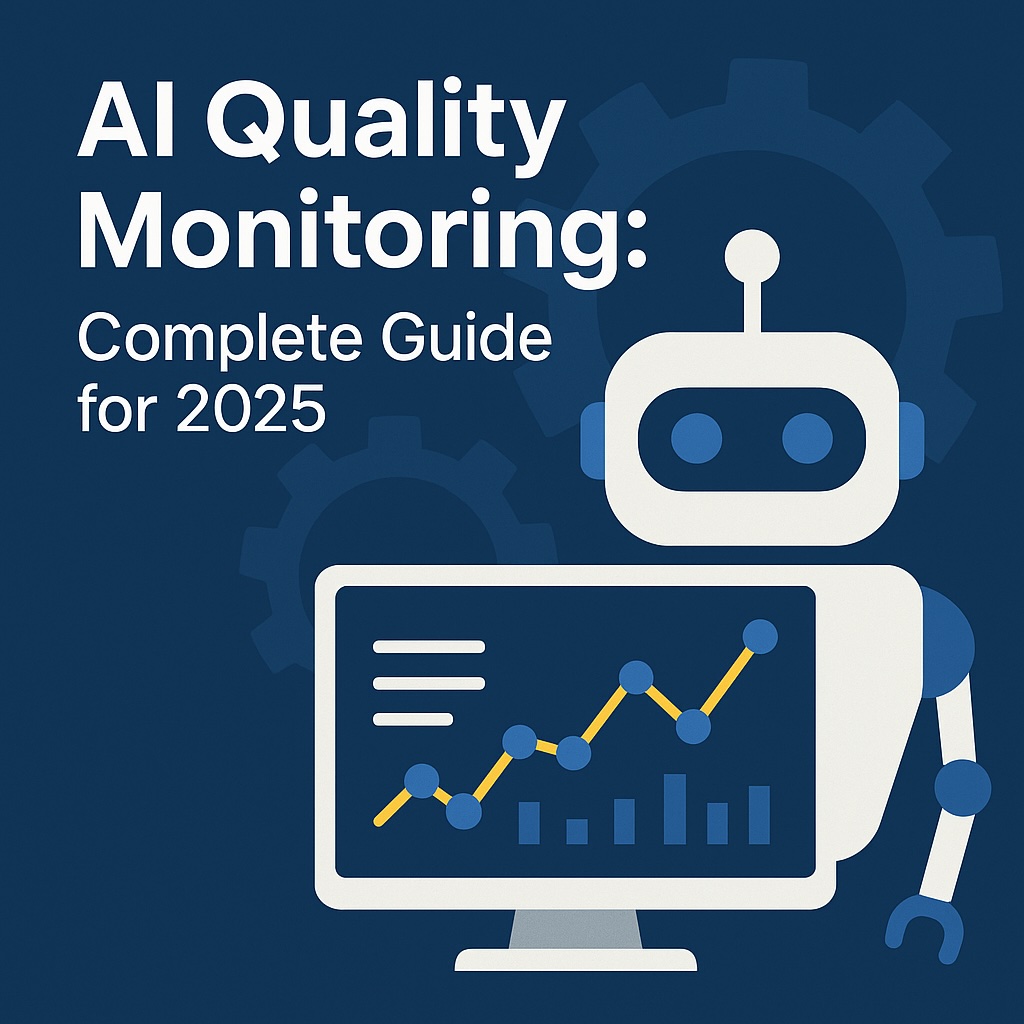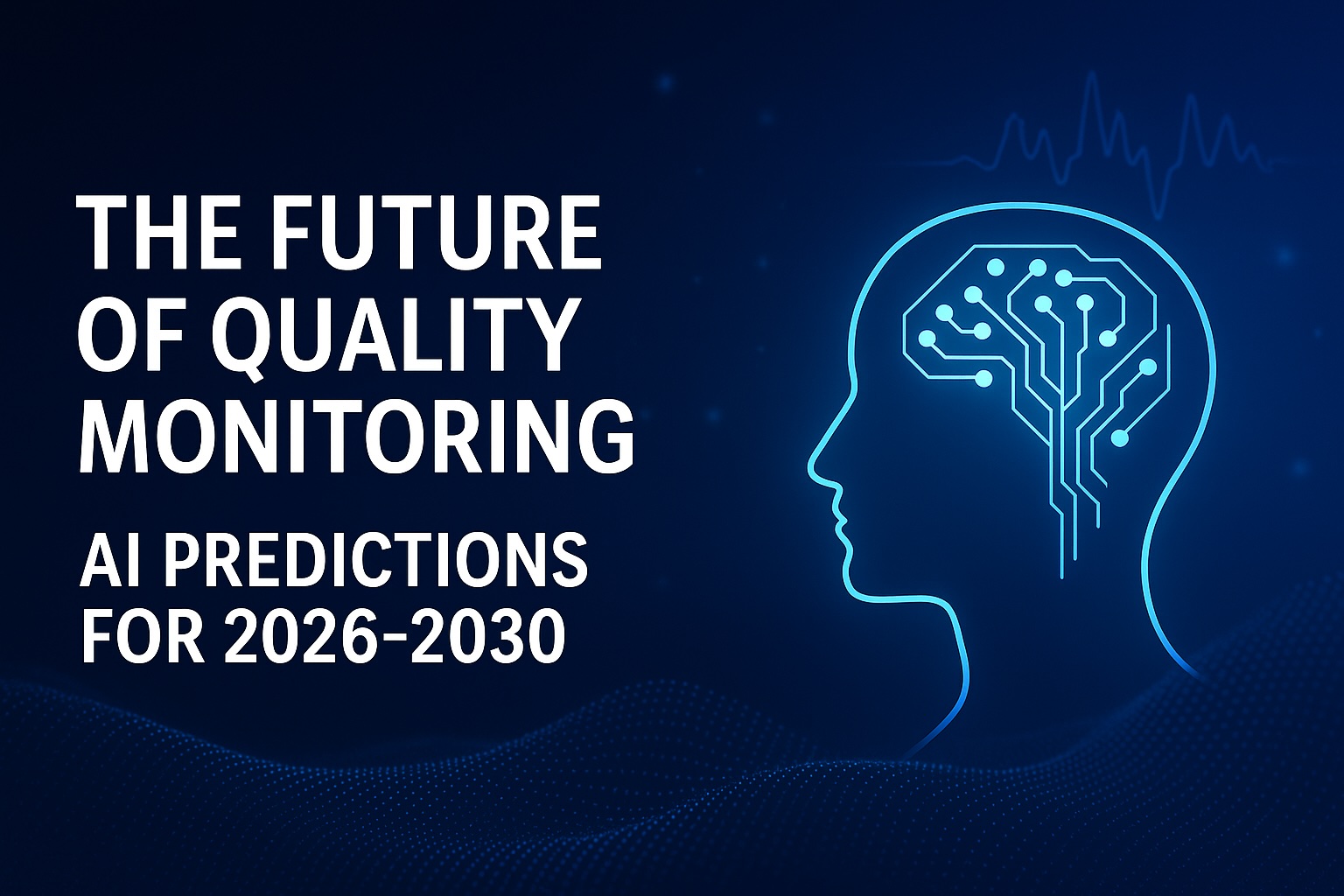
AI Quality Monitoring: Complete Guide for 2025
What is AI Quality Monitoring?
AI quality monitoring uses artificial intelligence to automatically evaluate customer interactions across channels—calls, emails, chats, and tickets—against predefined quality criteria.
Unlike traditional quality assurance, AI-powered systems can analyze 100% of interactions instead of small samples, provide instant scoring rather than delayed feedback, identify patterns humans might miss, scale infinitely without adding headcount, and maintain consistency eliminating scorer bias.
Organizations implementing AI quality monitoring report 90% reduction in manual review time, 20x increase in conversation coverage, 15-25% improvement in customer satisfaction scores, and 30% faster agent onboarding.
How AI Quality Monitoring Works
Speech-to-text technology converts voice calls to text using automatic speech recognition, achieving 90-95% accuracy with clear audio while handling multiple languages and identifying speakers.
Natural language processing analyzes conversation structure and content through intent detection, entity extraction, topic modeling, and semantic understanding. NLP distinguishes meaning beyond keywords, understanding context that simple keyword matching misses.
Sentiment analysis detects emotional tone throughout conversations, tracking overall sentiment, sentiment trajectory showing how emotions shift, peak moments identifying frustration spikes, and agent tone evaluating empathy and professionalism. Modern sentiment analysis achieves 80-85% accuracy for clear positive and negative cases.
Automated scoring grades conversations against your quality criteria. You define quality questions, provide expected answer descriptions for each scoring level, and AI analyzes transcripts to assign scores and identify coaching opportunities.
Pattern recognition identifies trends across conversations including common objections, recurring customer pain points, best practices from top performers, compliance violations, and training gaps by agent or team.
Real Capabilities vs Marketing Hype
AI excels at consistency at scale, evaluating thousands of conversations with identical criteria every time. It provides objective data analysis measuring talk time, silence periods, interruptions, and speaking pace. Instant feedback enables same-day coaching instead of waiting weeks. Pattern detection spots trends across thousands of interactions and uncovers hidden issues sampling would miss.
AI still struggles with complex context and nuance, missing sarcasm and cultural context that requires human judgment. Non-verbal communication like tone, sighs, and long pauses are challenging. Subjective quality aspects like genuine empathy require human interpretation. Industry-specific expertise in healthcare, legal, and financial conversations needs domain knowledge.
Best practice in 2025 uses a hybrid approach where AI handles 100% initial scoring, objective metrics, pattern detection, and compliance checks while humans handle complex case review, subjective quality assessment, coaching, and AI model refinement.
Key AI Techniques Explained
Natural language processing understands human language meaning beyond keywords. Where old keyword-based approaches flagged only exact word matches, NLP understands intent regardless of wording. This delivers 40% more accurate intent detection and works across languages without translation.
Sentiment analysis operates at three levels. Overall sentiment classifies conversations as positive, neutral, or negative. Sentiment trajectory tracks emotion changes showing customer frustration recovered to satisfaction. Granular emotion detection identifies specific emotions like anger, joy, confusion, and relief mapped to conversation moments.
Automated scoring requires defining specific measurable criteria, providing scoring guidance for different levels, and AI training through analyzing thousands of past conversations. Objective criteria like script adherence achieve 90-95% AI accuracy. Semi-objective criteria like issue resolution reach 80-85% accuracy. Subjective criteria like empathy achieve 65-75% accuracy and benefit from human review.
Conversation intelligence extracts strategic insights beyond quality scores. It detects competitor mentions automatically, identifies product feedback themes, tracks sales intelligence on what talk tracks convert best, and pinpoints training gaps showing where teams struggle.
Implementation Approach
Start by defining your quality framework with 5-7 critical criteria for different conversation types. Establish baseline metrics measuring current review percentage, average review time, scorer consistency, and feedback timing.
Run a pilot program starting with one team or conversation type. Compare AI scores versus human baseline through weekly calibration sessions. Target 85%+ agreement with human reviewers before scaling.
Expand coverage gradually adding teams, channels, and conversation types. Monitor accuracy with each expansion and adjust criteria for new contexts.
Establish ongoing processes where QA teams spot-check AI scores weekly on 10-15% samples, conduct monthly calibration sessions, and perform quarterly comprehensive accuracy audits.
AI vs Manual Comparison
Manual quality monitoring covers 2-5% of conversations with days to weeks for feedback. It has high labor costs that don't scale. Accuracy varies by reviewer with subjective bias. Depth provides strong context understanding but pattern detection is limited.
AI quality monitoring covers 100% of conversations with real-time to minutes feedback. It has low per-conversation cost. Accuracy reaches 85-90% on objective criteria with 100% consistency. Depth is strong on data but weaker on nuance. Pattern detection is automatic and comprehensive.
Hybrid approaches combine 100% AI scoring with 10-15% human review. This delivers real-time scores with deeper review as needed, best of both objective and contextual analysis, and achieves 90-95% accuracy with human calibration.
Cost example for 100 agents making 5,000 calls daily shows manual monitoring with 3% sample rate costs $500,000-700,000 annually covering only 3% of calls. AI monitoring costs $200,000-270,000 annually covering 100% of calls, saving $300,000-430,000 annually with 33x more coverage.
Real Results
A B2B SaaS company with 50 salespeople analyzed 100% of sales calls across six months. AI identified that top performers asked 11 discovery questions versus 4 for bottom performers. Specific question sequences correlated with 34% higher close rates. Early pricing mention before value establishment showed 43% lower win rates. Training middle performers on top performer techniques increased average deal size 18%, shortened sales cycles by 12 days, and improved win rates from 23% to 31%.
Limitations to Understand
AI accuracy varies by use case. Objective compliance checks reach 95%+ accuracy. Semi-objective metrics like issue resolution achieve 80-85% accuracy. Subjective assessments like empathy quality reach 65-75% accuracy requiring human review.
Sarcasm and cultural nuance remain challenging. Complex context outside training data confuses AI. Non-verbal communication is largely invisible. Industry-specific expertise requires human domain knowledge.
False positives and negatives occur. Budget 10-15% of conversations for human quality review to catch AI errors and maintain accuracy through calibration.
Future Trends
Real-time coaching will provide agents with live guidance during conversations. Predictive quality will score conversations before they end based on early indicators. Emotional intelligence will improve with better detection of subtle emotional cues. Multimodal analysis will combine voice, video, and text for richer evaluation. Hyper-personalization will adapt quality criteria by customer segment and context.
Getting Started
Define what quality means for your specific organization across different conversation types. Start with objective measurable criteria before tackling subjective assessments. Plan for 2-3 months from implementation to scaled deployment. Budget for platform costs plus reduced but still necessary human QA resources. Expect 6-12 months to realize full ROI as processes mature and accuracy improves.
The organizations succeeding with AI quality monitoring in 2025 embrace it as a tool to augment human judgment, not replace it. They invest in proper setup and ongoing calibration. They use insights to drive meaningful coaching and business improvements.
AI quality monitoring delivers unprecedented visibility into customer interactions at scale. Used properly with human oversight, it transforms quality assurance from a compliance checkbox into a strategic driver of performance improvement.




